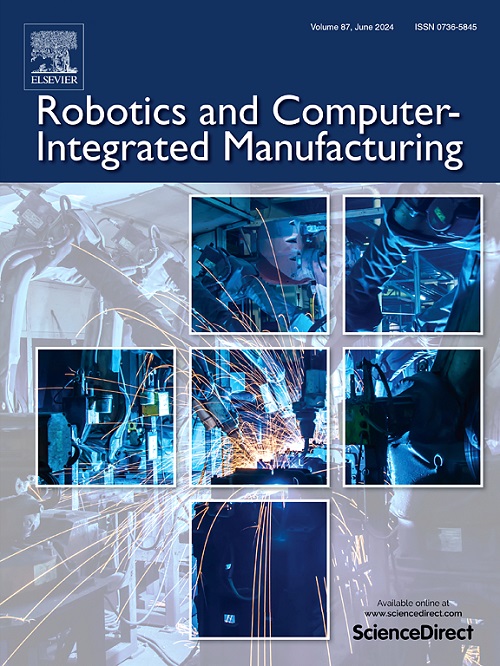Robotic abrasive cloth flap wheel polishing system and multivariate parameter decision-making method for blade leading and trailing edges
IF 11.4
1区 计算机科学
Q1 COMPUTER SCIENCE, INTERDISCIPLINARY APPLICATIONS
引用次数: 0
Abstract
The surface quality of the blade leading and trailing edges (LTE) impacts jet-engine performance. This study constructs a robotic abrasive cloth flap wheel (ACFW) polishing system and proposes a multivariate parameter decision-making method for the optimal polishing surface quality of the blade LTE. The robotic polishing system, including machine vision, offline programming, and constant force control, is first developed, and the blade polishing process, including blade clamping, on-machine measurement, position compensation, and polishing strategies, is then analyzed. Finally, a multivariate parameter decision-making method is proposed based on the surface roughness regression model (RM) and adaptive genetic algorithm-backpropagation (AGA-BP) network. The surface roughness RM, influencing factors, and the response curve are determined through a full factorial design (FFD) and the response surface methodology (RSM). Meanwhile, the AGA-BP network, which integrates the adaptive genetic algorithm (AGA) and backpropagation neural network (BPNN), is proposed to model and predict the roughness of the blade surface. Based on the optimal parameters, the surface roughness of the blade LTE will reach Ra = 0.142μm, which illustrates that the developed robotic polishing system is highly efficient and feasible. Furthermore, the mean error percentages of the RM, BPNN, and AGA-BP predictions are 17.946%, 9.633%, and 1.495%, respectively, for four random test datasets. The maximum error for the AGA-BP network is 1.995%, while the minimum is 0.758%. This network model can accurately predict surface roughness for the robotic polishing system of the Ti-6Al-4V blade LTE.
机器人砂布襟翼轮抛光系统及叶片前后缘多变量参数决策方法
叶片前后缘的表面质量直接影响喷气发动机的性能。构建了机器人磨布皮瓣轮(ACFW)抛光系统,提出了叶片LTE最优抛光表面质量的多参数决策方法。首先开发了包括机器视觉、离线编程和恒力控制在内的机器人抛光系统,然后分析了刀片抛光过程,包括刀片夹紧、机内测量、位置补偿和抛光策略。最后,提出了一种基于表面粗糙度回归模型(RM)和自适应遗传算法-反向传播(AGA-BP)网络的多参数决策方法。通过全因子设计(FFD)和响应面法(RSM)确定了表面粗糙度RM、影响因素和响应曲线。同时,将自适应遗传算法(AGA)和反向传播神经网络(BPNN)相结合,提出了AGA- bp网络对叶片表面粗糙度进行建模和预测。在优化参数的基础上,叶片LTE的表面粗糙度达到Ra = 0.142μm,表明所开发的机器人抛光系统是高效可行的。此外,对于4个随机测试数据集,RM、BPNN和AGA-BP预测的平均错误率分别为17.946%、9.633%和1.495%。AGA-BP网络的最大误差为1.995%,最小误差为0.758%。该网络模型可以准确预测Ti-6Al-4V叶片LTE机器人抛光系统的表面粗糙度。
本文章由计算机程序翻译,如有差异,请以英文原文为准。
求助全文
约1分钟内获得全文
求助全文
来源期刊
CiteScore
24.10
自引率
13.50%
发文量
160
审稿时长
50 days
期刊介绍:
The journal, Robotics and Computer-Integrated Manufacturing, focuses on sharing research applications that contribute to the development of new or enhanced robotics, manufacturing technologies, and innovative manufacturing strategies that are relevant to industry. Papers that combine theory and experimental validation are preferred, while review papers on current robotics and manufacturing issues are also considered. However, papers on traditional machining processes, modeling and simulation, supply chain management, and resource optimization are generally not within the scope of the journal, as there are more appropriate journals for these topics. Similarly, papers that are overly theoretical or mathematical will be directed to other suitable journals. The journal welcomes original papers in areas such as industrial robotics, human-robot collaboration in manufacturing, cloud-based manufacturing, cyber-physical production systems, big data analytics in manufacturing, smart mechatronics, machine learning, adaptive and sustainable manufacturing, and other fields involving unique manufacturing technologies.

 求助内容:
求助内容: 应助结果提醒方式:
应助结果提醒方式:


